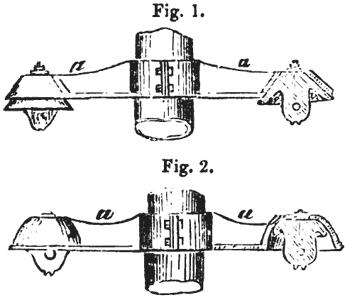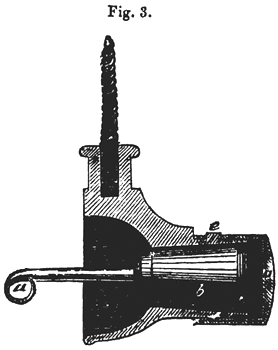[Trade Journal]
Publication: The Mechanics Magazine
London, England
vol. 65, no. 1728, p. 277, col. 1-2
IMPROVED INSULATORS FOR TELEGRAPH WIRES.
MR. EDWIN CLARK has recently introduced an improvement in insulating telegraph wires, according to which the arms and the caps, by which the suspension above the earth is accomplished, in place of being made separate in each case, are made of one piece of metal or other suitable material, and the cap and arm is made with a gutter to carry off rain from above the insulator, which is suspended within the carp.
 |
Fig. 1 shows a side view, partly in section, of one form given by him to the arms and cap; Fig. 2 shows a side view, partly in section, of another form. The forms of the arms and the caps may be varied so long as an arm and cap is in one piece, as shown. a, a, are the metal arms, terminating with inverted hollow metal caps of a suitable form for receiving the earthenware or glass insulator for suspending the wires. The caps are made with gutters around them, as shown. The arms and inverted hollow caps are best made of one piece of cast iron, though wrought iron or other metal may be used, and even earthenware might be employed.
Mr. John Woodman of Manchester, has also introduced an improved telegraph wire insulator. Instead of cementing the stalk of the hook through which the wire passes into a thimble, and cementing the said thimble into a cylindrical chamber of cast-iron bell, he makes the bell open at the back, with a cap or cover to fit closely on it. He fastens the stalk of the hook or eye into a conical shaped non-conductor, which he passes through the bell at the back. By its conical shape, the smallest part being foremost, it forms a wedge, whereby the more stress or strain comes upon it the tighter it fits, and thus becomes waterproof; and as an additional tightener, an elastic ring is put round the thick end of the non-conductor, which causes it to fit perfectly close, and the cap or cover being then put on, and secured by a peg or pin, preserves it from the weather or accident. It is evident, that by this plan, whenever the hook or eye becomes broken or out of order, it may be taken out and repaired, or replaced with a new one, without disturbing the whole of the insulator, by merely taking off the cap or cover, and taking out the non-conductor and hook or eye.
 |
Fig. 3 of the engravings is a view of the insulator complete. a represents the hook or eye; b, the conical shaped non-conductor; c, the elastic ring, and d the cap or cover which slides on the outside of the bell, and is secured by the pin or projection e.
